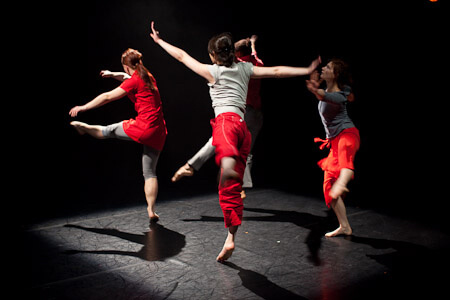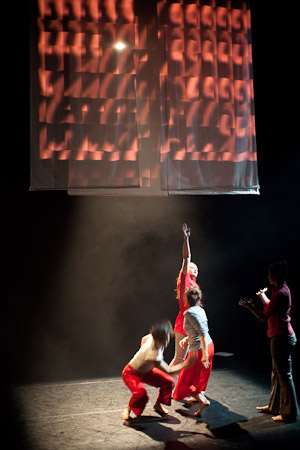In this first Act I am constructing ‘thinking’ within an embodied perspective, and refuting a mind-body divide. I call this ‘choreo-thinking’. I begin by dispatching the Spector of ‘Cogito ergo sum’ by using the concept of Dewey’s mind-full-body. From the static of sitting and writing I move to liberate thinking into the world of doing.
1(Dewey and Boydston 2008, 111)
Act One: The analysis of thinking is traditionally assumed to happen in words, that is the postgraduate thesis was traditionally written in order to evidence the thinking behind it. But as a dyslexic I do not ‘think’ with words, and I find words three or four processes removed from my inner communication of ideas. Yet woven across the postgraduate research journey there is a continual expectation of expressing meaning through words (written or verbal). This expectation of words being interchangeable with meaning can unwittingly be carried on into your own inner analysis processes. This essay is an invitation to explore approaches I use to untangle meaning from the tensions of the wordy alcove of postgraduate research and inhabit the wordless process of my inner ‘thinking’.
Act Two: In my practice the act of choreographing is a process of exploring physical questions, the choreography manifesting as the explorative response to these questions. I have questions about my use of weight: If I lift my leg here and push my hips to the side and lift my arm such, what happens to my weight? The subsequent movement becomes the choreographed step. Or if this dancer passes their weight on to the back of this dancer, in that corner of the stage. As I choreograph I am ‘keeping’, ‘discarding’, ‘adapting’ the movements that manifest from these questions of physicality. My choices reveal the framework that inhabits the aesthetic of the choreography. The choreography then starts to have its own aesthetic grammar. That is, the choices I am making expose the assumptions and meaning I am bringing to the movement that emerges from my questions. And so, choreographing offers modes of raising and exploring questions that leads to physical answers and in turn leads to a new understanding of…
In this act, I am bypassing words by using the wordless-doing-language of movement and the grammar of my own choreographic aesthetic to explore my assumptions, questions and witness my conclusions.
Act Three: Above I used the example of exploring weight–exchange to stimulate choreographic inquiry/movement making. We are familiar with using physical concepts (such as weight-exchange, speed, size, dynamic balance) to stimulate movement inquiry. In Act Three I ask myself what if I inject into the choreographic studio space questions that clearly linger in both the physical and theoretical of postgraduate research. Instead of weight exchange, can I choreograph ethnographic-exchange? Would this be a solo – is ethnography something one becomes? Do I see ethnography and I dancing with each other – is it a duet? Is ethnography the ensemble of people and environment?
The goal is not to make up a dance! It is to use the problems choreographing raises (the choreographic problems solving I am familiar with) to ask myself where I stand on the notion I am exploring (in this case Ethnography). If I decide choreographically I dance ethnographic-exchange as a solo sequence rather than see it as dance partnered with another dancer, what does that tell me about the role I see mySelf in during the ethnographic process? Why?
In this act, I am interrogating where I stand on research methods by physicalising them. To stand back and look at what I create when I do this, to see what it reveals about the assumptions I bring to my research methodology. I can comprehend the ‘thinking’ produced by my own practice of choreography far more easily and with more room for play and surprise than I can if I attempt to use the writing of words as a process for understanding my thoughts.
How would I choreograph the relationships in transcribing an interview? Would this involve Dancer 2 copying Dancer 1? What would be copied? Can Dancer 2 ‘be’ Dancer 1? Would Dancer 2 be reproducing, representing: therefore, is transcription representational? Or a reproduction? What would I be ok sacrificing in the reproduction? Why? Is transcription one dancer representing many? What does this say about the role of transcription in my research?
Where would speed be in the choreography of the impact a literature review was having on my analysis?
Where is weight in the choreography of the experience of a single interview? How would my questions and use of weight differ in choreography about a questionnaire?
Coda to Act Three: Above I have created hybrid choreographic-questions by asking myself to use the physicality of movement to explore questions about elements in the research of my study. A coda to this is to extend exploration in the space the choreography collaborates with – the stage in this case. In this coda, I am seeing the theoretical framework as the space in which things happen. In a postgraduate research project, you will have a theoretical framework. How would you choreograph the relationships between the elements of the framework?
I ask myself what are the elements of my theoretical framework that I am currently seeing as fundamentally different from each other? Or that others see as different? For instance: ‘past’ and ’present’ ‘thought’ and ‘material’. Below I write about interrogating the research I was doing about children’s experiences of school buildings:
Developing my methodology: I begin my thinking/feeling by choreographing/designing for the ‘site’ of a stage space, a traditional black box. I was also interested in exploring differences between notions of ‘thought’ and ‘material’. This was near the beginning of the research and I was not sure what I understood their relationship to be. I divided the visual eye-line of the audience in half, horizontally across the stage. The area from the stage floor to the height the dancers could jump was choreographed in form (material), the area above the level the dancers could jump to the ceiling of the theatre was choreographed in projected light (thought). This meant that the audience viewing the work saw both halves of the horizontal divide as one picture. The form/physical half of the stage was where the dancers moved. The light/thought half of the stage was where I used projection of filmed movement. (Akinleye 2012)
As I work I ask how these elements of my theoretical framework respond in relation to each other? Does conceiving of them as separation kerb me? When? Does their separation make something impossible?
The goal of the task is to create/design a space to move through. It is that moving through it that reveals what elements of my framework mean to me beyond a neat coming together of theoretical ideas.
For instance: If I had ‘present’ as visible space on the stage and ‘past’ as space behind a screen with only shadows of what is behind it visible to the audience. What would this tell me as I move through this space. Does the light of the visible space of ‘present’ effect the shadows of ‘past’ when I move through them? Or should the light that creates the shadows of ‘past’ come from a different source than the light of the visible space of ‘present’? If so what is that source? What happens to it, to my body when I move through the space of conceptualising ‘past/present’?
I try a few designs to experience how elements from my framework interact. I might find that when I am moving behind the screen in the shadows of ‘past’ that the lights of ‘present’ actually blinds me. I don’t become too intense!! – this could just mean I need a technician to help me move the light to a different part of the stage …but it also raises interesting questions about what ‘present’ does to ‘past’.
Act Four: Thoughout this play lands at the feet of embodied metaphor. Above I have been playing with a blurring of physical / theoretical realisation of ideas through bridging gaps between them with metaphor. In ‘Metaphors we live by’, Lakoff and Johnson (1980) give a number of examples of metaphor in language that is physicalised. For instance, the metaphor of argument as war,
your claims are indefensible, he attacked every weak point in my argument (Lakoff and Johnson 1980, 4)
They ask what if we used the metaphor of argument as dance rather than argument as war?
I can play with this in the studio moving with one or two other dancers to see how we could dance an argument. Then we see if we can use an existing piece of choreography as documentation of an argument (argument a dance).
I choose this example because often the postgraduate thesis is contextualised as presenting an argument. Just unpicking my default embodied metaphors is hugely thought provoking. I can go further and see what my own arguments with a thesis looks like when they are no longer constructed as defensive (war) and instead have the attributes of a dance (for instance exchange, fast/slow, forwards/backwards). It can feel counter intuitive but we are playing to see what wordless moments of movement it reveals.
Closing Act: The goal of these acts of ‘choreo-thinking’ is to use movement to stimulate your thinking/feeling on theoretical elements of your research. The goal of these acts of play is not perfection or finality (i.e. we are not making a completed dance.) Although you might make something, this is secondary to the meaning-making processes you encounter and reveal about your ‘thinking’.
Note
- (Dewey and Boydston 2008, 111)
Reference List and Additional Materials
Akinleye, Adesola. 2012. Body, Dance and Environment: an exploration of embodiment and identity. Unpublished PhD. Canterbury Christ Church University.
Akinleye, Adesola. 2015. Her life in Movement: Reflections on embodiment as a methodology chapter in Wellard, Ian. Researching Embodied Sport: Exploring movement cultures, Routledge, 178–196.
Dewey, John, and Jo Ann Boydston. 2008. The later works of John Dewey, 1925–1953. Carbondale: Southern Illinois University Press.
Lakoff, George, and Mark Johnson. 1980. Metaphors we live by. Chicago: University of Chicago Press.
Adesola Akinleye
Dr. Akinleye is Senior Lecture at Middlesex University. Her work explores the embodied narratives people construct to make meaning of their lived experiences. She has a particular interest in ‘Place’ a co-constructed transaction across mind-full-body and environment for which dance offers languages.

